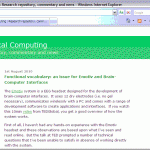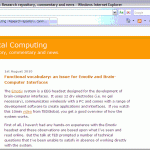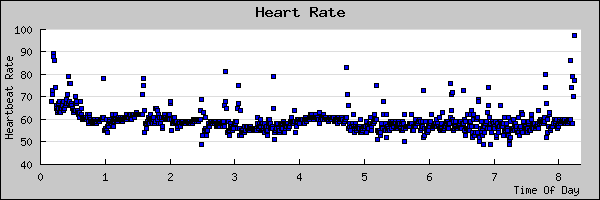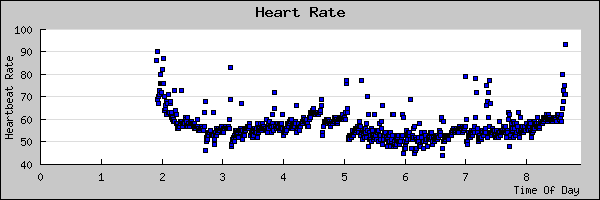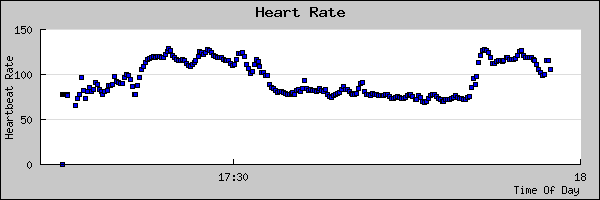With only hours left until Nintendo’s E3 press event I’ve once again been pondering what we’ll see from the Wii Vitality. At last year’s E3 the device’s announcement didn’t exactly wow the audience. It’s not surprising as Nintendo didn’t provide a demonstration of the device which might have bought gamers into the concept. Nintendo have remained tight lipped ever since revealing absolutely nothing about what we might expect from the device. Over the past year it has been suggested the Vitality will be used to monitor the scare factor in games, alter game difficulty, be used as an input for relaxation and exercise games as well as in lie-detection of which I discussed one particular method of implementation here.
Implementing these types of games are indeed possible using physiological measures and you can see versions of these games in the biofeedback and academic game communities for example: –
- The Journey to Wild Divine: series of relaxation mini-games controlled using heartbeat rate and skin conductance.
- A Fitness Game Reflecting Heart Rate: boxing game which adapts the gameplay in order to move you towards a target heartbeat rate. Enemy characters require a different physical movement to destroy them, depending on the player’s current heartbeat rate and the goal an appropriate enemy will be selected.
- Fairies: target acquisition game which alters the player’s perception of the games difficulty according to the player’s level of arousal as denoted by heartbeat rate.
There are many ways you can use physiological data in gameplay, it’s all a question of how you make the input meaningful for the player (e.g. if the player’s relaxation level is used to switch between character states, those states have to be somewhat representative of the change, so if the player is controlling an avatar with a pyrotechnic ability then a shift from a relaxed state to an agitated state could be used to trigger their fire ability and vice versa, this would be a meaningful relationship).
The problem I have with the Vitality is in their choice of sensor: a finger based pulse oximeter. A pulse oximeter uses infra-red to track the changes in the volume of blood in the extremities and from this derive heartbeat rate. If you want to support a wide selection of different play styles (e.g. relaxation, exercise, affective) a finger based sensor would not have been my first choice considering the following issues: –
- A finger based sensor limits the player’s freedom of movement. Any physical activity will move the sensor from its recording position and may even possibly become disconnected, both events of which will create data errors. And depending on how responsive the game is to the player’s physiology it can easily lead to erroneous game behaviour. This will limit how the data can be used in a given context (e.g. a game responsive to emotional physiological responses is not suited to a game involving gestures, this example is more prelevant for the Wii as the system sells itself on physical interaction as the standard input method). Also the physicality of the sensor attachment to the player’s finger restricts player movement so physical actions may become uncomfortable (e.g. imagine playing Red Steel with a cable attached to your finger). This is not to say games involving physical actions will be taboo using the Vitality (e.g. a calorie counter in an exercise game), it just makes it harder.
- With a finger based sensor use of the second Nunchuk is liable to become awkward possibly eliminating it as an input device.
Ideally Nintendo should have gone with either an earlobe based pulse oximeter thereby freeing up the hands (though physical actions still have to be limited as that sensor is not the most secure under intense movement) or ideally a chest-strap*. A chest-strap sensor provides the most secure method of measuring a player’s heartbeat rate as the centre of the body is pretty stable under movement, this is especially true from my perspective given I’ve been wearing one for the last several months collecting data.
At this point these issues are pretty much moot (more like irritations in my noggin I can’t dispell) as I suspect Nintendo will launch the system with a series of relaxation games which the Vitality is clearly geared for**. Or perhaps a lie-detection game as I’ve talked about before.
* The problem inherent in using a chest-strap is in how the player may perceive it invading their personal space. The chest-strap is an up-and-close personal wearable device, and I imagine given the new wireless heart monitor EA Sports Active 2.0 is using (an armband based heart monitor), there development staff thought so too. The finger attachment does not invade the player’s space so there is no unease in wearing the device. Having just seen EA’s E3 press conference, the Vitality is already looking obsolete.
**The sensor used by The Journey to Wild Divine has been used in a multitude of different game genres, my favourite being the Half-Life 2 mod Please Don’t Feed the BioZombies. However the sensor is used in conjunction with a mouse and keyboard and this setup doesn’t suffer from player movement to the same degree the Vitality will given the nature of the input device doesn’t require much. Also unlike Vitality a mouse and keyboard is placed on a flat providing support for the hand the sensor is on.


